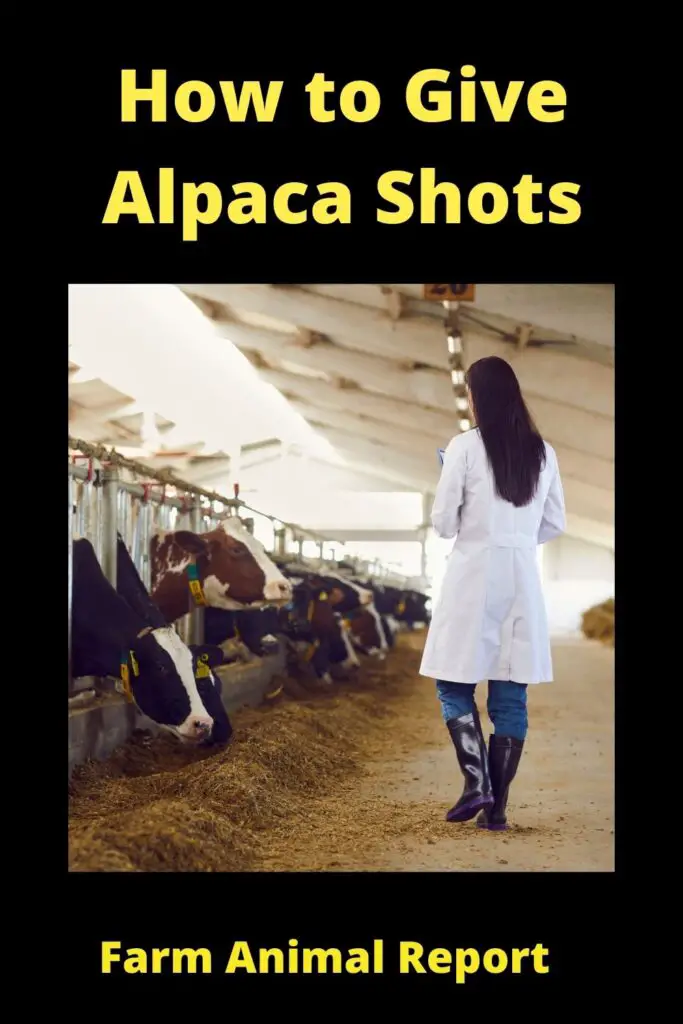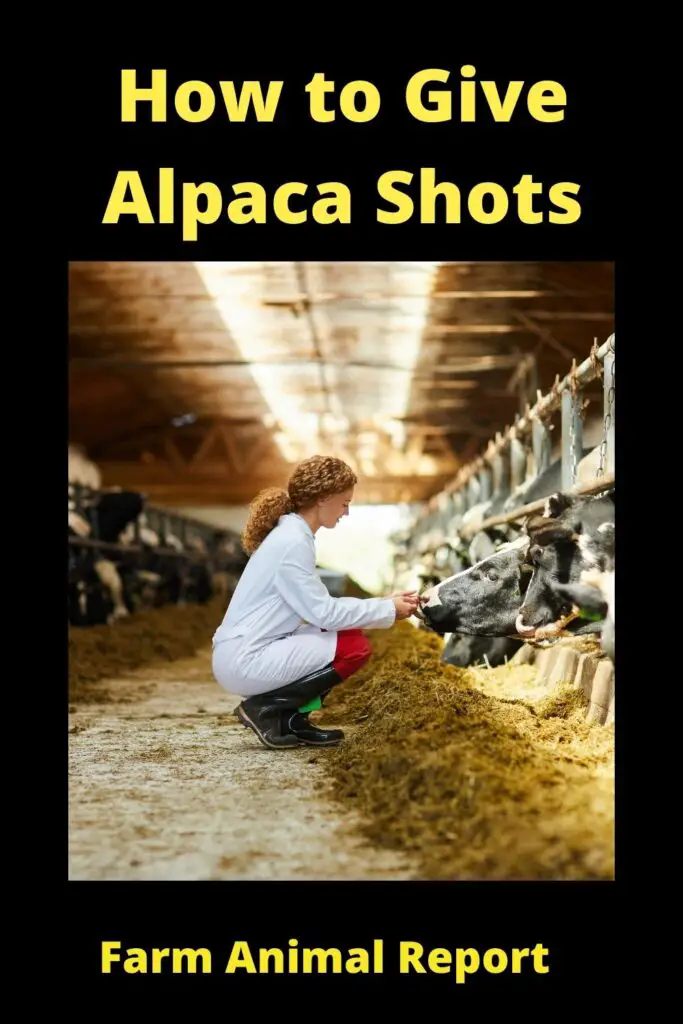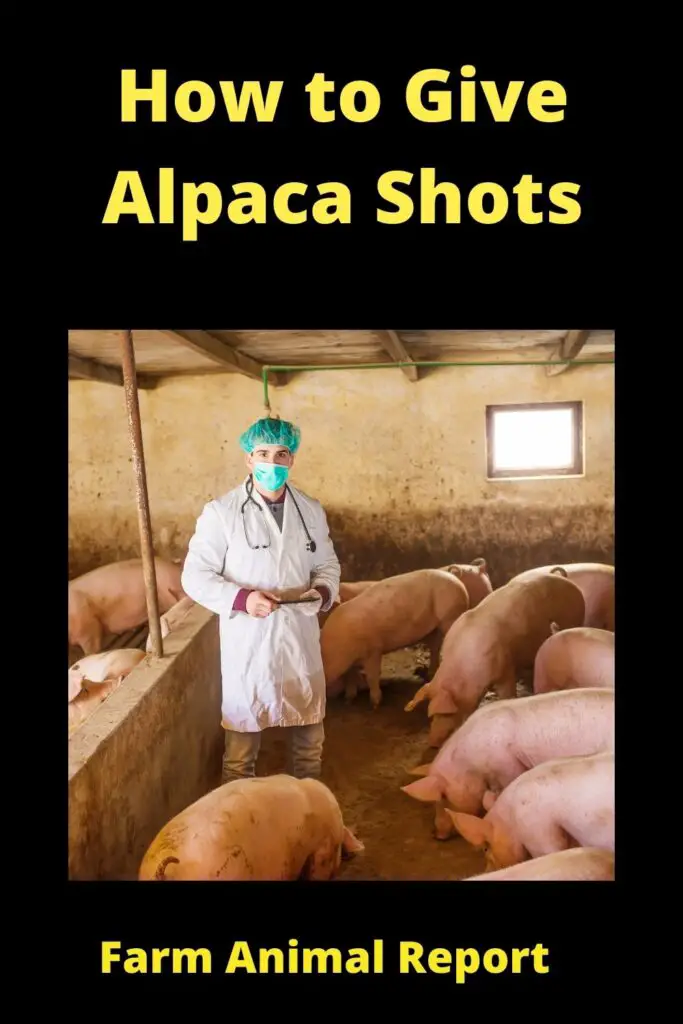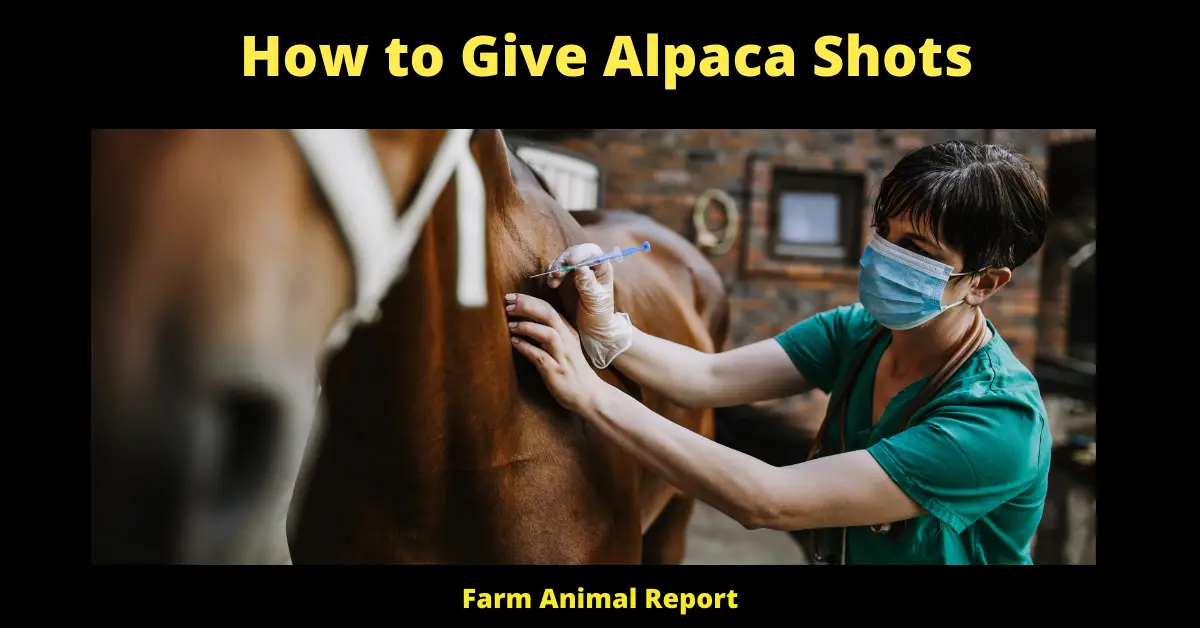As a general rule make sure fur is wetted down. Make an X-shape with the shot needle and forcefully jab it into your Alpaca’s hind leg. Make sure to pull the needle away quickly after you do this; otherwise, your Alpaca might kick around in pain! The skin of an alpaca is fragile, so that would be very painful for them if their skin were ripped open. You should never give your alpaca shots in the head, neck, or stomach area!
How to Give Alpaca Shots
Alpacas are pretty small creatures, so it is easy for them to get sick and die if they don’t receive proper medication or immunization shots. You should make sure that you always have some form of vaccination with you in case an alpaca gets sick or if they are not getting the proper nourishment.
How to Give Alpaca Shots – Alpacas are most susceptible to Coccidiosis, which is a disease that causes bloody stool and lethargy. It can prove fatal if not treated properly. If your Alpaca has signs of Coccidiosis, you should immediately separate it from the herd and bring it into a small, enclosed area. Then get your alpaca shot directly!
To give an alpaca a shot, first make sure that their fur is wetted down. This will prevent the inoculation needle from pulling any hair out of your Alpaca.
Then, make an X-shape with the shot needle and forcefully jab it into your Alpaca’s hind leg. Make sure to pull the needle away quickly after you do this; otherwise, your Alpaca might kick around in pain! The skin of an alpaca is fragile, so that would be very painful for them if their skin were ripped open. You should never give your alpaca shots in the head, neck, or stomach area!
When you are finished with giving an alpaca its immunizations, make sure to wash off any blood that got on the needle. This will prevent any diseases from transferring from the Alpaca to you.

What Shots / Vaccines do Alpacas Need?
The following are vaccines usually used in all adult alpacas, regardless of whether they have health problems, are pregnant or not pregnant, or other factors.
Annual Booster DHPPL vaccine
How to Give Alpaca Shots – This should be the only vaccine, other husbandry practices, necessary for any animal who has already received a DHPPL vaccine as a cria. The first booster is one year following the initial killed vaccines, and after that, boosters are given every year.
Annual Booster Tetanus vaccine
Pregnancy Week 30 Estradiol Valerate Shot: This shot should be given during week 30 of pregnancy to help minimize abortions caused by Estrus or Twins.
Pregnancy Week 45 Estradiol Valerate Shot: This shot should be given during week 45 of pregnancy to help minimize preterm deliveries and premature labor.
Optional, but recommended in adult alpacas, especially if show quality or intended for breeding stock use. These vaccines are not required for alpacas but are recommended to optimize
Annual Booster Tetanus vaccine: (tetanus is not typically a problem in alpacas. However, this disease is present in many places where alpacas are kept).
Pregnancy Week 8 Folic Acid Shot: Because most crias are born on the ground, and because crias sometimes nurse before they can stand to nurse, there is a risk of birth injuries during delivery. There is evidence that is giving folic acid eight weeks before the due date reduces the risk of such damages.
Pregnancy Week 30 or 60 Twin Shot: This shot should be given during week 30 or week 60 of pregnancy, depending on which is more convenient for you. Research has shown that this shot can significantly reduce the incidence of preterm delivery and twin births in llamas/alpacas. This shot must be given within 72 hours after birth to have any effect whatsoever.
Pregnancy Week 45 Cephalexin Shot: There is evidence that giving cephalexin to the dam during and after pregnancy significantly reduces the risk of mastitis and other problems associated with delivery. This shot must be given at least one week before birth but preferably two weeks before the due date.
What is a CDT Shot for Alpacas?
A CDT shot is an immunization for pregnant alpacas that helps protect the crias against enterotoxemia. It is typically given to pregnant alpacas at or near the end of their 15th month of pregnancy, although some breeders decide to give it as early as their 11th month.
Enterotoxemia, also known as overeating disease, is a bacterial infection of the intestine caused by ingestion of feed containing high non-structural carbohydrates, such as starch and sugar. The bacteria in the Alpaca’s digestive system ferment these sugars to produce a toxin called “Shiga,” which causes vasoconstriction (narrowing of the blood vessels), and decreased blood flow to the kid’s intestine, and ultimately death. Crias infected with this disease typically die within 36 hours of exposure.
This CDT shot is not the same as a CD&T (Clostridium perfringens Type C & D Toxoid) immunization that many breeders give to their pregnant alpacas. Although enterotoxemia is often associated with Clostridium perfringens Type C & D Toxoid, the bacteria are two different strains with no relationship.
It is generally accepted that this CDT shot will not protect crias from exposure to the disease by older alpacas. The cria would have to be exposed within the first 15 days of life before antibodies are passed from the pregnant dam to her cria.
Where are Alpaca Injection Sites?
Alpacas are a domesticated animal that is closely related to the llama. They are used for their wool, meat, and hides. Alpacas are also used as beasts of burden in many parts of the world. In this blog post, we will discuss the various injection sites on an alpaca.
The best places to give an injection on an alpaca are the neck, inner thigh, and buttock. The easiest way to give a shot is directly into the muscle of either one of these areas. However, if you need to inject something that is only soluble in fat or oil (such as B12), then it would be best to inject it under the skin.
The neck is the most common site for injections because it’s relatively easy to get to and has plenty of muscle tissue surrounding it, making needle insertion less painful than if you were injecting into a thinner area like an ear or leg.
When do you Vaccinate Alpacas?
The decision to vaccinate or not is a personal choice and should be made on an individual basis. Why? There is a considerable debate about whether it is beneficial for alpacas to be vaccinated with Clostridial vaccines during gestation. A Clostridial vaccine stimulates the immune system to produce antibodies against the toxins created by certain species of bacteria known as Clostridia. Clostridia perfringens, Clostridia septicum, and Clostridia novyi type C are most associated with these vaccine reactions.

When do you Vaccinate cria?
When you are expecting a cria, it is essential to be prepared for its arrival. Preparation should start six months before the expected due date. At this point, find out what vaccinations were given to the dam while she was pregnant so that you will know how many weeks are left until the cria can get its first vaccinations. The baby should receive the initial shots at six to eight weeks and 14-16 weeks. This is because antibodies from the dam interfere with the vaccine’s ability to stimulate antibody production in the baby. When it comes time for weaning, your veterinarian can help you decide if there are other vaccinations that your cria might need.
What do you Vaccinate Alpacas With?
Alpacas are one of the most gentle and docile animals. They also have particular health needs that need to be addressed regularly. Typically, alpacas receive vaccinations against clostridium perfringens types C and D (toxins A and B) and tetanus.
This vaccine is often combined with a vaccine against enterotoxemia (toxins A and B). This vaccination is typically given every six months to adult alpacas and yearly to crias.
How to Hold Your Alpaca to give them Shots
Now that you have a new Alpaca, or “Llama,” in your possession, it is essential to know how to hold them properly. Keeping an Alpaca can be a sort of animal handling feat in itself! The trick here is not to use a halter, which they may not tolerate.
Instead, keep the Alpaca’s head free and gently rest your hand on their forehead. Then try to get the animal in a standing position for liquid medication or frequent injections. First, you may need to help them up with some lure like food or play with them for a moment. Alternatively, they may hop up quickly when it is an opportune moment.
Once they are up, hold them in place with your body weight and the leash if possible, this gives you time to grab their neckline for better control. When having an Alpaca’s neck, you want to use two hands for optimal safety, one on either neck region just behind the base of their ear. Of course, always use extreme caution when handling any animal – Alpacas are large animals that may be pretty strong when they want to be.
How Long to Observe them after giving them a Shot?
You should observe the animal from one hour before it gets vaccinated until at least four hours after the vaccination. That way, you’ll get an accurate picture of the effect of the shot on that particular animal. It’s essential to observe an alpaca’s behavior after vaccination to understand how safe they are for use in breeding or as pets.
Alpacas usually receive their vaccinations when they have other shots to stop Coccidiosis or something similar. Some animals will be completely unaffected by the vaccination, while others will exhibit adverse reactions. If an alpaca isn’t acting generally after being vaccinated, Kohn says that the best thing to do is keep your eye on it for a few hours.

Where do you Vaccinate Alpacas?
Vaccines should be injected subcutaneously (below the skin), NOT into the muscle (intramuscular injections sq). Utilize short needles to facilitate this. At the base of the neck, in front of the shoulder blade, where there is loose skin on the side of the neck, insert the needle at a shallow angle. Avoid injecting too close to the dorsal midline to avoid the neck’s large ligament. Avoid injecting too close to the ventral midline to avoid the trachea and adjacent significant nerves and blood vessels. Avoid self-injection by not picking up the skin with your other hand! Subcutaneous injections can also be made in the hairless area on the lateral thorax, behind the elbow. When the fleece is short, these injection sites are easier to access. For vaccination protocols, consult your local veterinarian for advice on vaccine use in alpacas on your farm.
18 ways Alpaca Farmers make Money
Final Thought
For alpacas to live a long and healthy life, they must be appropriately vaccinated and have reasonable parasite control. Vaccinating alpacas isn’t like vaccinating dogs or cats; you can’t just go up to the animal and inject them like you could with humans. Always consult your veterinarian for advice on vaccinating your Alpaca.


